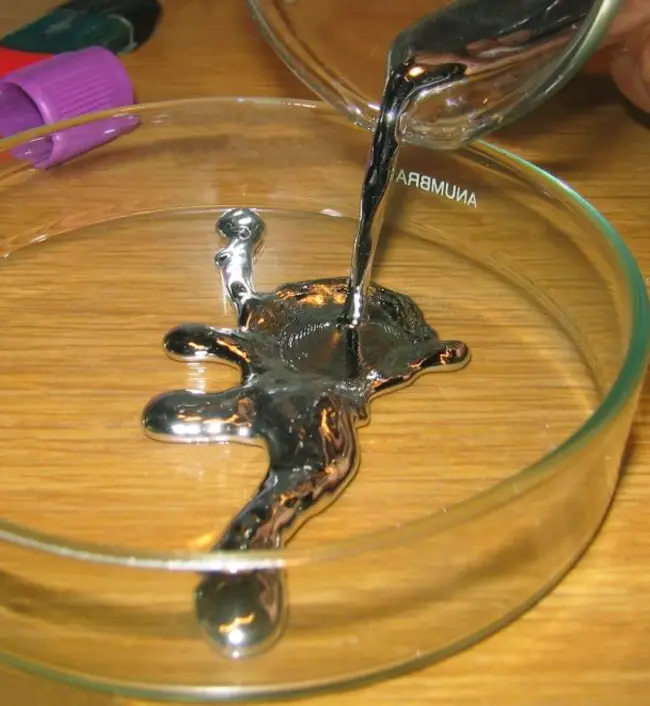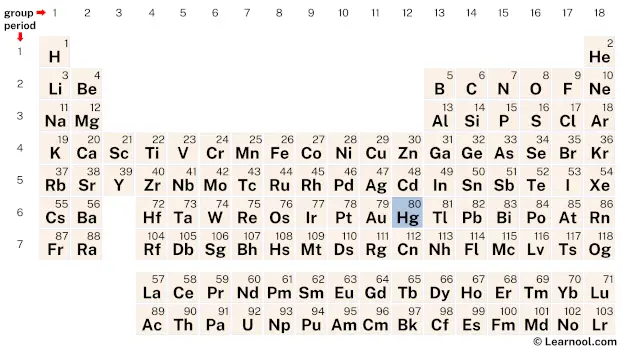
Mercury (Hg), also known as quicksilver, is a chemical element of the periodic table, located in the group 12 and the period 6, and is having the atomic number 80. It is a shiny, silvery liquid metal, which is named after the planet, Mercury. It is highly toxic and is counted as one of the post transition metals.
On periodic table
| group | ⇨ | 1 | 2 | 3 | 4 | 5 | 6 | 7 | 8 | 9 | 10 | 11 | 12 | 13 | 14 | 15 | 16 | 17 | 18 |
| period | ⇩ | ||||||||||||||||||
| 1 | 1 H  Hydrogen |
2 He  Helium |
|||||||||||||||||
| 2 | 3 Li  Lithium |
4 Be  Beryllium |
5 B  Boron |
6 C  Carbon |
7 N  Nitrogen |
8 O  Oxygen |
9 F  Fluorine |
10 Ne  Neon |
|||||||||||
| 3 | 11 Na  Sodium |
12 Mg  Magnesium |
13 Al  Aluminium |
14 Si Silicon |
15 P  Phosphorus |
16 S  Sulfur |
17 Cl  Chlorine |
18 Ar  Argon |
|||||||||||
| 4 | 19 K  Potassium |
20 Ca  Calcium |
21 Sc  Scandium |
22 Ti  Titanium |
23 V  Vanadium |
24 Cr  Chromium |
25 Mn  Manganese |
26 Fe  Iron |
27 Co  Cobalt |
28 Ni  Nickel |
29 Cu  Copper |
30 Zn  Zinc |
31 Ga  Gallium |
32 Ge  Germanium |
33 As  Arsenic |
34 Se  Selenium |
35 Br  Bromine |
36 Kr  Krypton |
|
| 5 | 37 Rb  Rubidium |
38 Sr  Strontium |
39 Y  Yttrium |
40 Zr  Zirconium |
41 Nb  Niobium |
42 Mo  Molybdenum |
43 Tc  Technetium |
44 Ru  Ruthenium |
45 Rh  Rhodium |
46 Pd  Palladium |
47 Ag  Silver |
48 Cd  Cadmium |
49 In  Indium |
50 Sn  Tin |
51 Sb  Antimony |
52 Te  Tellurium |
53 I  Iodine |
54 Xe  Xenon |
|
| 6 | 55 Cs  Caesium |
56 Ba  Barium |
72 Hf  Hafnium |
73 Ta  Tantalum |
74 W  Tungsten |
75 Re  Rhenium |
76 Os  Osmium |
77 Ir  Iridium |
78 Pt  Platinum |
79 Au  Gold |
80 Hg Mercury |
81 Tl  Thallium |
82 Pb  Lead |
83 Bi  Bismuth |
84 Po  Polonium |
85 At  Astatine |
86 Rn  Radon |
||
| 7 | 87 Fr  Francium |
88 Ra  Radium |
104 Rf  Rutherfordium |
105 Db  Dubnium |
106 Sg  Seaborgium |
107 Bh  Bohrium |
108 Hs  Hassium |
109 Mt  Meitnerium |
110 Ds  Darmstadtium |
111 Rg  Roentgenium |
112 Cn  Copernicium |
113 Nh  Nihonium |
114 Fl  Flerovium |
115 Mc  Moscovium |
116 Lv  Livermorium |
117 Ts  Tennessine |
118 Og  Oganesson |
||
| 57 La  Lanthanum |
58 Ce  Cerium |
59 Pr  Praseodymium |
60 Nd  Neodymium |
61 Pm  Promethium |
62 Sm  Samarium |
63 Eu  Europium |
64 Gd  Gadolinium |
65 Tb  Terbium |
66 Dy  Dysprosium |
67 Ho  Holmium |
68 Er  Erbium |
69 Tm  Thulium |
70 Yb  Ytterbium |
71 Lu  Lutetium |
|||||
| 89 Ac  Actinium |
90 Th  Thorium |
91 Pa  Protactinium |
92 U  Uranium |
93 Np  Neptunium |
94 Pu  Plutonium |
95 Am  Americium |
96 Cm  Curium |
97 Bk  Berkelium |
98 Cf  Californium |
99 Es  Einsteinium |
100 Fm  Fermium |
101 Md  Mendelevium |
102 No  Nobelium |
103 Lr  Lawrencium |
|||||
| – d block |
Mercury is a d-block element, situated in the twelfth column and the sixth row of the periodic table. Its atomic number is 80 and its symbol is Hg.
Element information
 |
|
 |
|
| Origin of name | named after planet Mercury |
| Symbol | Hg |
| Atomic number (Z) | 80 |
| Atomic mass | 200.59 u |
| Block | d-block |
| Group | 12 |
| Period | 6 |
| Classification | Post-transition metal |
| Atomic radius | 151 pm |
| Covalent radius | 132±5 pm |
| Van der Waals radius | 155 pm |
| Melting point | -38.8290 ℃, -37.8922 ℉, 234.3210 K |
| Boiling point | 356.73 ℃, 674.11 ℉, 629.88 K |
| Electron configuration | [Xe] 4f14 5d10 6s2 |
| Learn how to write: Mercury electron configuration | |
| Electrons per shell | 2, 8, 18, 32, 18, 2 |
| Learn how to draw: Mercury Bohr model | |
| Crystal structure | Rhombohedral |
| Phase at r.t | Liquid |
| Density near r.t | 13.534 g/cm3 |
| Main isotopes | Mercury-196, Mercury-198, Mercury-199, Mercury-200, Mercury-201, Mercury-202, Mercury-204 |
| Natural occurrence | Primordial |
| Oxidation state | +1, +2 |
| Electronegativity (Pauling scale) | 2.00 |
| Protons Neutrons Electrons |
80 120 80 |
| Learn how to find: Mercury protons neutrons electrons | |
| CAS number | 7439-97-6 |
| Discovered by | Ancient Egyptians before 1500 BCE |
History
Mercury has a rich and complex history dating back to ancient times. The earliest recorded use of the element can be traced back to ancient Egypt, where it was used for cosmetic purposes and in religious ceremonies. It was believed to have protective properties and was used in eye makeup to ward off evil spirits. Additionally, mercury was used in the production of religious offerings and was sometimes included in tombs as an offering to the gods.
In ancient Greece and Rome, mercury was used for medicinal purposes, including treating skin disorders and as a diuretic. The element was recognized as a distinct substance by the ancient Chinese, who referred to it as “quicksilver” and used it in traditional medicine to treat a variety of ailments, such as syphilis and gonorrhea. Mercury was also used in alchemy, a practice that aimed to transform base metals into gold or silver. While alchemy was largely discredited as a scientific practice, it played a crucial role in the development of modern chemistry, with many of the early pioneers in the field being alchemists.
In modern times, mercury has been used in a wide range of industrial applications, including the production of thermometers, barometers, and fluorescent lights. However, its toxicity and potential harm to human health and the environment have led to increased regulation and reduced usage in many industries. Despite this, mercury still plays a role in some traditional medicines and cultural practices, particularly in parts of Asia and Africa. The history of mercury is a fascinating reflection of its many uses and its enduring legacy throughout human history.
Occurrence and production
Mercury is a relatively rare element in the Earth’s crust, with an average concentration of just 0.08 parts per million. It occurs naturally in the form of cinnabar, a red mineral composed of mercury(Ⅱ) sulfide. Cinnabar deposits are found all over the world, but the largest reserves are in China, Spain, and the United States.
Mercury can also be found in small quantities in other minerals such as sphalerite, galena, and chalcopyrite. It is also present in seawater, where it exists in trace amounts.
Mercury is typically produced by the mining of cinnabar ore, which is then heated to release the mercury vapor. This vapor is then condensed and purified to produce liquid mercury. Most of the world’s mercury supply comes from small-scale artisanal mining operations, which can pose significant environmental and health hazards due to the release of mercury vapor and the improper disposal of mercury-containing waste.
In addition to mining, mercury can also be produced by the recycling of mercury-containing products such as fluorescent light bulbs, thermometers, and batteries. The recycling process involves heating the products to release the mercury vapor, which is then condensed and purified. However, this process can also lead to the release of mercury vapor and requires proper handling to prevent environmental contamination and health risks.
Properties
Mercury is a dense, silvery-white metal with a unique physical property of being a liquid at room temperature.
It has a very high surface tension, allowing it to form beads or droplets that can easily break apart.
Mercury has a very low boiling point of 356.73 ℃ and a melting point of -38.8290 ℃.
It is a poor conductor of heat, but a good conductor of electricity.
Mercury has a high vapor pressure, which means it can easily evaporate and become airborne.
It has a strong affinity for sulfur and readily forms compounds with it.
Mercury is highly toxic and can cause severe damage to the nervous system and other organs in the body if ingested or inhaled.
Applications
Thermometers
Mercury is commonly used in glass thermometers due to its high coefficient of thermal expansion, which makes it easy to measure temperature changes. However, due to its toxicity, other substances are now used instead of mercury in most modern thermometers.
Electrical switches and relays
Mercury’s high electrical conductivity and low contact resistance make it useful in electrical switches and relays. It can also be used in fluorescent lamps, although its use in this application is declining due to environmental concerns.
Dental fillings
Amalgam dental fillings are a mixture of mercury and other metals such as silver, tin, and copper. This mixture creates a strong, durable material that is resistant to wear and tear, making it ideal for dental fillings.
Mining
Mercury is used in small-scale gold mining to extract gold from ore. The mercury-gold amalgam is then heated to evaporate the mercury, leaving behind the gold.
Chemical production
Mercury is used in the production of various chemicals, including chlorine and caustic soda. It is also used as a catalyst in some chemical reactions.
Barometers
Mercury is used in barometers due to its high density, which allows for accurate measurements of atmospheric pressure.
Pharmaceuticals
Some pharmaceuticals contain small amounts of mercury compounds as preservatives. However, the use of mercury in pharmaceuticals has declined in recent years due to concerns over its toxicity.
Interesting facts
The element mercury is the only metal that is liquid at room temperature.
Mercury has been known since ancient times and was used in various applications such as medicine, cosmetics, and alchemy.
The name “mercury” comes from the Roman god Mercury, who was known for his speed and mobility, which is fitting for the liquid metal.
Mercury is highly toxic and can cause damage to the nervous system, kidneys, and other organs. Because of this, it has been phased out of many consumer products and industrial processes.
Mercury is still used in some applications such as fluorescent lighting, thermometers, and some types of batteries.
The largest natural deposit of mercury is found in the Almadén mine in Spain, which has been in operation since Roman times.
Mercury has the unique property of forming amalgams with other metals, which has made it useful in various scientific and industrial applications.
In addition to its physical properties, mercury has interesting optical properties. It has a high refractive index, which makes it useful in some types of lenses and mirrors. It also exhibits a phenomenon called liquid mirror reflection, where its surface can be used as a highly reflective mirror for certain wavelengths of light.
Related
More elements
External links
- https://en.wikipedia.org/wiki/Mercury_(element)
- https://www.rsc.org/periodic-table/element/80/mercury
- https://www.britannica.com/science/mercury-chemical-element
- https://www.chemicool.com/elements/mercury.html
- https://education.jlab.org/itselemental/ele080.html
- https://www.thoughtco.com/mercury-element-facts-608433
Deep
Learnool.com was founded by Deep Rana, who is a mechanical engineer by profession and a blogger by passion. He has a good conceptual knowledge on different educational topics and he provides the same on this website. He loves to learn something new everyday and believes that the best utilization of free time is developing a new skill.
